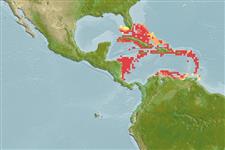>
Holocentriformes (Squirrelfishes, soldierfishes) >
Holocentridae (Squirrelfishes, soldierfishes) > Holocentrinae
Etymology: Neoniphon: Greek, neos = new + Greek, niphon = to snow (Ref. 45335).
More on author: Cuvier.
Environment: milieu / climate zone / Tiefenbereich / distribution range
Ökologie
seewasser riff-verbunden; tiefenbereich 1 - 70 m (Ref. 9710), usually 30 - 60 m (Ref. 9710). Tropical; 27°N - 10°N, 85°W - 60°W
Western Atlantic: Florida Keys, USA and Bahamas to Trinidad. Antilles and throughout Caribbean (Ref. 26938).
Size / Gewicht / Alter
Geschlechtsreife: Lm ? range ? - ? cm
Max length : 18.0 cm TL Männchen/unbestimmt; (Ref. 26340)
Rückenflossenstacheln (insgesamt) : 11; Rückenflossenweichstrahlen (insgesamt) : 12 - 14; Afterflossenstacheln: 4; Afterflossenweichstrahlen: 9. Body striped with red, yellow and silver; often anterior third of body more yellow than remainder. Third anal ray spine very long and stout (Ref. 26938). Body slender, spiny dorsal fin with broad yellow band along middle and lower sides (Ref. 37108).
Body shape (shape guide): fusiform / normal.
Rarely found in shallow water, but appears to be the most common squirrelfish in the depth range of 30-60 m or more (Ref. 32). Reported used as food fish (Ref. 37108).
Life cycle and mating behavior
Geschlechtsreife | Fortpflanzung | Ablaichen | Eier | Fecundity | Larven
Böhlke, J.E. and C.C.G. Chaplin, 1993. Fishes of the Bahamas and adjacent tropical waters. 2nd edition. University of Texas Press, Austin. (Ref. 5521)
IUCN Rote Liste Status (Ref. 130435: Version 2025-1)
Bedrohung für Menschen
Harmless
Nutzung durch Menschen
Fischereien: weniger kommerziell
Tools
Zusatzinformationen
Download XML
Internet Quellen
Estimates based on models
Preferred temperature (Ref.
123201): 23.7 - 27.7, mean 26.6 °C (based on 29 cells).
Phylogenetic diversity index (Ref.
82804): PD
50 = 0.5039 [Uniqueness, from 0.5 = low to 2.0 = high].
Bayesian length-weight: a=0.01585 (0.00766 - 0.03278), b=2.97 (2.79 - 3.15), in cm total length, based on LWR estimates for this (Sub)family-body shape (Ref.
93245).
Trophic level (Ref.
69278): 3.6 ±0.4 se; based on diet studies.
Widerstandsfähigkeit (Ref.
120179): hoch, Verdopplung der Population dauert weniger als 15 Monate. (Preliminary K or Fecundity.).
Fishing Vulnerability (Ref.
59153): Low vulnerability (10 of 100).
🛈
Nutrients (Ref.
124155): Calcium = 82.3 [37.2, 256.7] mg/100g; Iron = 0.795 [0.331, 1.616] mg/100g; Protein = 18.5 [17.3, 19.7] %; Omega3 = 0.18 [0.07, 0.43] g/100g; Selenium = 36.2 [21.2, 69.5] μg/100g; VitaminA = 76.3 [29.6, 206.6] μg/100g; Zinc = 1.5 [1.0, 2.3] mg/100g (wet weight);
